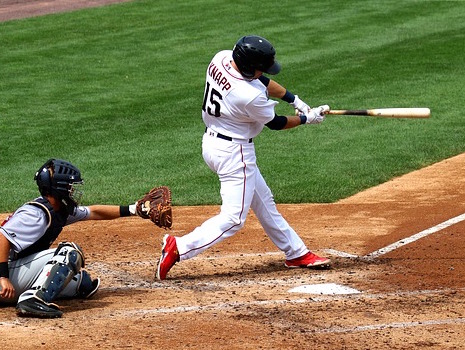The importance of being aggressive early at the plate
July 17, 2017 by Coach McCreary
Filed under Hitting, Mental Side
As all of my readers know, baseball is a very cerebral game. The difference between winning and losing & succeeding and failing at the game often is more about what is going on between the ears and not in the physical things you can see. No area of the game is immune to this either. Think better and you will have better results.
One of the million examples of this in a game is when hitters are very aggressive early in the game and early in the count. I certainly don’t mean out-of-control aggression where hitters are swinging at everything thrown at them. For this example, I am referring to hitters that take a very healthy swing that is right on time on pitches they can handle early in the count and game. If hitters in a line-up do this well, it typically changes most pitchers’ thinking immediately.
Here are two different scenarios …
Hitters on Team A come out of the gate and ease their way into the game. Most of the batters take early pitches to get a feel for the pitcher and the strike zone. The pitcher gets ahead typically with fastballs, gets a lot of 0-1 counts and then proceeds to go to work with off-speed stuff. The pitchers’ confidence increases which makes his command and overall pitching better. If he didn’t warm-up properly before the game, hitters on Team A allow him to get his legs under him and “warm-up” over the first couple innings. Team A’s hitters try to flip the switch the second time through the order but now they are facing a fully warmed-up pitcher with lots of confidence and good command.
Hitters on Team B take a different approach. They come out swinging. Right from the first inning, hitters attack pitches that are in the zone early in the count. They take even healthier swings in fastball counts and are right on time at the contact point. Some pitches may be hit but many of them might be swung at and missed or hit foul. When this occurs, the thinking of the pitcher and whoever is calling the pitches (catcher and/or coach) usually shifts in the hitters’ favor. In short, doubt starts to creep in.
When hitters are aggressive early in the count/game, the pitcher (and pitch-callers) realizes that they better be careful about laying that first pitch in there in the future. The hitters that already hit the ball hard will probably continue to do so and the hitters that swung through or fouled off the pitch may start to square them up. As a result (and this is the key!), they start to do something different. Instead of laying that first pitch over the plate, they start to try to move it to the corners and/or low. They start to add more off-speed or breaking pitches to early pitches in the count. When that occurs, more 1-0 and 2-0 counts will begin the surface and the confidence shifts from pitcher to batter. Add to this the fact that most young pitchers don’t warm-up properly and you now have a very toxic environment for the pitcher
In Team A’s scenario, the hitters are more in a mindset of fear in that they are behind in the count, are more likely to see more quality pitches (especially off-speed pitches), and have a greater likelihood of striking out because all of that is being done by a very confident thrower on the hill. The pitcher in this scenario has very little fear and simply continues to do what he has done to get hitters out which is to just throw strikes. In Team B’s scenario, the fear shifts to the pitcher. The aggressive swings have led to the pitcher being more tentative. More hitting counts emerge. Hitters gain more confidence and the pitcher is now more likely to have the mindset of fear. He recognizes that he can no longer “just throw strikes.” He has to throw to smaller areas of the strike zone which, of course, is much harder to do.
All this is why coaches would always rather have a team that is too aggressive than not aggressive enough. It is much easier to calm hitters down and channel their aggression to pitches inside the strike zone than to inject aggression into hitters that start out with very little.






Leave a Reply